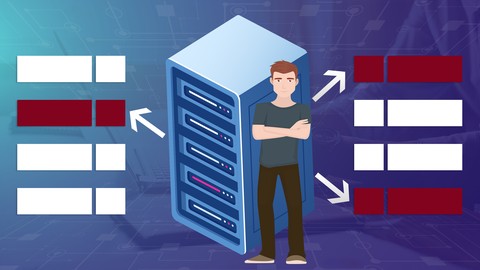
Relational Database Design concepts
Relational Database Design concepts, available at $19.99, has an average rating of 4.1, with 26 lectures, based on 65 reviews, and has 4164 subscribers.
You will learn about How to design a database schema, how to set up tables, columns, data type, keys, relationship and how to normalize Practical examples for database design Best practices for creating database objects This course is ideal for individuals who are Database developers or Dababase designers It is particularly useful for Database developers or Dababase designers.
Enroll now: Relational Database Design concepts
Summary
Title: Relational Database Design concepts
Price: $19.99
Average Rating: 4.1
Number of Lectures: 26
Number of Published Lectures: 26
Number of Curriculum Items: 26
Number of Published Curriculum Objects: 26
Original Price: $39.99
Quality Status: approved
Status: Live
What You Will Learn
- How to design a database schema, how to set up tables, columns, data type, keys, relationship and how to normalize
- Practical examples for database design
- Best practices for creating database objects
Who Should Attend
- Database developers
- Dababase designers
Target Audiences
- Database developers
- Dababase designers
Description:
This course is about designing a database schema. How to create tables, columns, set data types for columns, identify keys, identify relationship between tables and normalize.
Database normalization is the process of structuring a database, usually a relational database, in accordance with a series of so-called normal forms in order to reduce data redundancy and improve data integrity. It was first proposed by Edgar F. Codd as part of his relational model.
Normalization entails organizing the columns (attributes) and tables (relations) of a database to ensure that their dependencies are properly enforced by database integrity constraints. It is accomplished by applying some formal rules either by a process of synthesis (creating a new database design) or decomposition (improving an existing database design).
No software installation is required. The database schema will be design using an online tool, also the SQL statements will be run inside the online tool Oracle livesql.
Why to start:
-
You want to know how to design your database schema.
-
You want to check if a database schema is designed correctly .
-
If you just started as a Oracle developer and want some knowledge about database design.
-
If you are a business person and just want to check if database objects are designed properly.
Course content:
The course has 4 chapters:
-
Database design concepts
-
Entities
-
Keys
-
Relationships
-
-
Database design steps
-
Design steps overview
-
Step 1 : The purpose
-
Step 2: Entities/Attributes/Data types
-
Step 3: Keys/ Candidate Keys/ Primary Keys
-
Step 4: Relationship
-
Step 5: Normalization
-
-
Practical examples
-
Student/activities example
-
Employees/skills
-
Dentist
-
-
Best Practices
-
Tables
-
Constraints
-
Indexes
-
Sequences
-
Views
-
Triggers
-
Next steps
-
The theory in this course is a must for a database designer or an oracle developer, but can be interesting for every persons that deals with databases.
Course Curriculum
Chapter 1: Dabatase design concepts
Lecture 1: Entities
Lecture 2: Keys
Lecture 3: Relationships
Chapter 2: Database design steps
Lecture 1: Design steps Overview
Lecture 2: Step 1: The purpose
Lecture 3: Step 2 : Entities/ attributes/ data types
Lecture 4: Step 2 : Details about data types
Lecture 5: Step 2 : Assign data types
Lecture 6: Step 3 : Keys
Lecture 7: Step 3 : Candidate keys
Lecture 8: Step 3 : Primary key
Lecture 9: Step 4 : Relationships
Lecture 10: Step 5: Normalization
Lecture 11: Step 5: Normalization 1st normal form
Lecture 12: Step 5: Normalization 2nd normal form
Lecture 13: Step 5: Normalization 3rd normal form
Chapter 3: Database Design Practical examples
Lecture 1: Students/ activities example
Lecture 2: Employees/ skills example
Lecture 3: Dentist example
Chapter 4: Best practices
Lecture 1: Tables
Lecture 2: Constraints
Lecture 3: Indexes
Lecture 4: Sequences
Lecture 5: Views
Lecture 6: Triggers
Lecture 7: Next steps
Instructors
-
Sultana Iulian
Oracle developer
Rating Distribution
- 1 stars: 2 votes
- 2 stars: 4 votes
- 3 stars: 17 votes
- 4 stars: 22 votes
- 5 stars: 20 votes
Frequently Asked Questions
How long do I have access to the course materials?
You can view and review the lecture materials indefinitely, like an on-demand channel.
Can I take my courses with me wherever I go?
Definitely! If you have an internet connection, courses on Udemy are available on any device at any time. If you don’t have an internet connection, some instructors also let their students download course lectures. That’s up to the instructor though, so make sure you get on their good side!
You may also like
- Best Yoga Instruction Courses to Learn in March 2025
- Best Stress Management Courses to Learn in March 2025
- Best Mindfulness Meditation Courses to Learn in March 2025
- Best Life Coaching Courses to Learn in March 2025
- Best Career Development Courses to Learn in March 2025
- Best Relationship Building Courses to Learn in March 2025
- Best Parenting Skills Courses to Learn in March 2025
- Best Home Improvement Courses to Learn in March 2025
- Best Gardening Courses to Learn in March 2025
- Best Sewing And Knitting Courses to Learn in March 2025
- Best Interior Design Courses to Learn in March 2025
- Best Writing Courses Courses to Learn in March 2025
- Best Storytelling Courses to Learn in March 2025
- Best Creativity Workshops Courses to Learn in March 2025
- Best Resilience Training Courses to Learn in March 2025
- Best Emotional Intelligence Courses to Learn in March 2025
- Best Time Management Courses to Learn in March 2025
- Best Remote Work Strategies Courses to Learn in March 2025
- Best Freelancing Courses to Learn in March 2025
- Best E-commerce Strategies Courses to Learn in March 2025






















